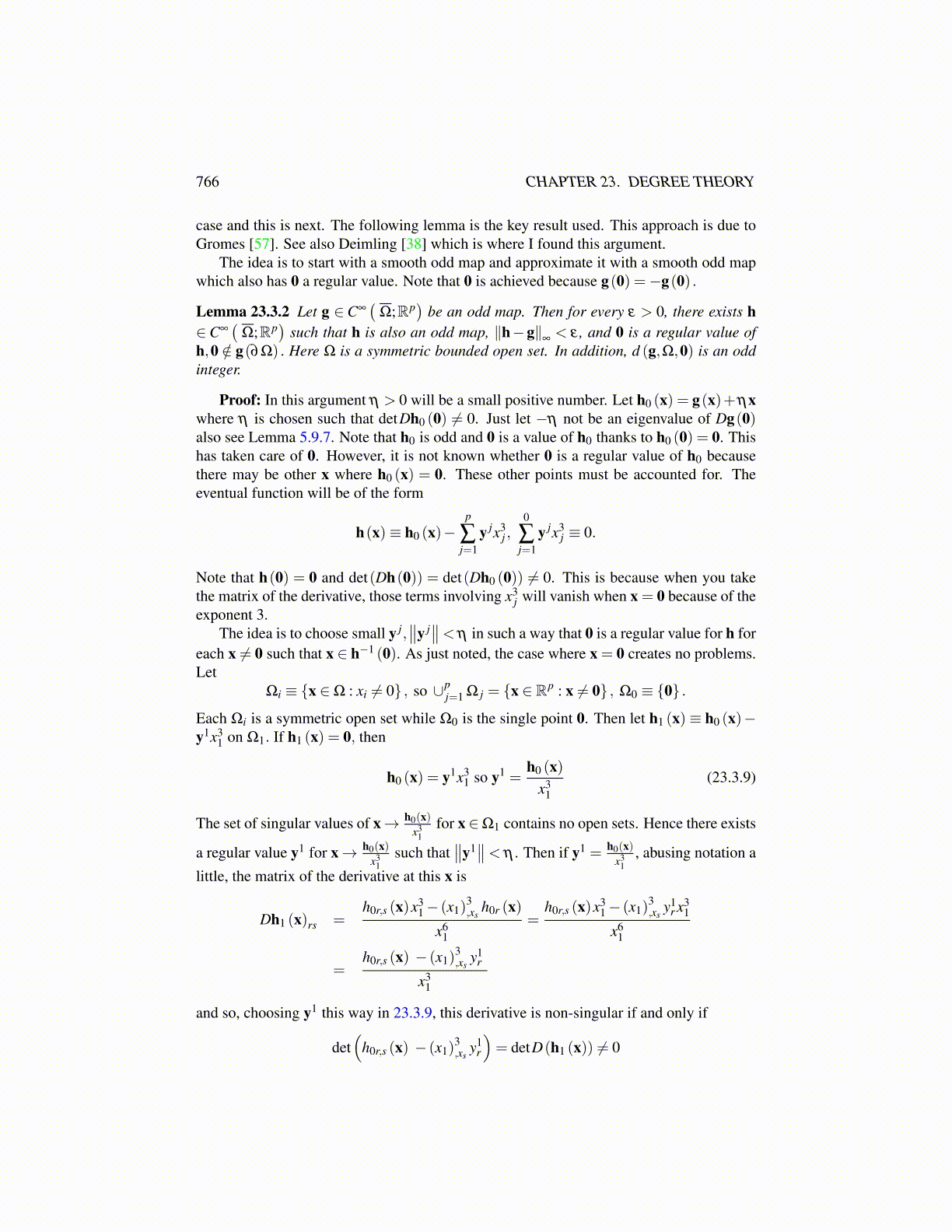
766 CHAPTER 23. DEGREE THEORY
case and this is next. The following lemma is the key result used. This approach is due toGromes [57]. See also Deimling [38] which is where I found this argument.
The idea is to start with a smooth odd map and approximate it with a smooth odd mapwhich also has 0 a regular value. Note that 0 is achieved because g(0) =−g(0) .
Lemma 23.3.2 Let g ∈C∞(
Ω;Rp)
be an odd map. Then for every ε > 0, there exists h∈ C∞
(Ω;Rp
)such that h is also an odd map, ∥h−g∥
∞< ε , and 0 is a regular value of
h,0 /∈ g(∂Ω) . Here Ω is a symmetric bounded open set. In addition, d (g,Ω,0) is an oddinteger.
Proof: In this argument η > 0 will be a small positive number. Let h0 (x) = g(x)+ηxwhere η is chosen such that detDh0 (0) ̸= 0. Just let −η not be an eigenvalue of Dg(0)also see Lemma 5.9.7. Note that h0 is odd and 0 is a value of h0 thanks to h0 (0) = 0. Thishas taken care of 0. However, it is not known whether 0 is a regular value of h0 becausethere may be other x where h0 (x) = 0. These other points must be accounted for. Theeventual function will be of the form
h(x)≡ h0 (x)−p
∑j=1
y jx3j ,
0
∑j=1
y jx3j ≡ 0.
Note that h(0) = 0 and det(Dh(0)) = det(Dh0 (0)) ̸= 0. This is because when you takethe matrix of the derivative, those terms involving x3
j will vanish when x = 0 because of theexponent 3.
The idea is to choose small y j,∥∥y j∥∥< η in such a way that 0 is a regular value for h for
each x ̸= 0 such that x ∈ h−1 (0). As just noted, the case where x = 0 creates no problems.Let
Ωi ≡ {x ∈Ω : xi ̸= 0} , so ∪pj=1 Ω j = {x ∈ Rp : x ̸= 0} , Ω0 ≡ {0} .
Each Ωi is a symmetric open set while Ω0 is the single point 0. Then let h1 (x)≡ h0 (x)−y1x3
1 on Ω1. If h1 (x) = 0, then
h0 (x) = y1x31 so y1 =
h0 (x)x3
1(23.3.9)
The set of singular values of x→ h0(x)x3
1for x∈Ω1 contains no open sets. Hence there exists
a regular value y1 for x→ h0(x)x3
1such that
∥∥y1∥∥< η . Then if y1 = h0(x)
x31
, abusing notation a
little, the matrix of the derivative at this x is
Dh1 (x)rs =h0r,s (x)x3
1− (x1)3,xs
h0r (x)x6
1=
h0r,s (x)x31− (x1)
3,xs
y1r x3
1
x61
=h0r,s (x) − (x1)
3,xs
y1r
x31
and so, choosing y1 this way in 23.3.9, this derivative is non-singular if and only if
det(
h0r,s (x) − (x1)3,xs
y1r
)= detD(h1 (x)) ̸= 0